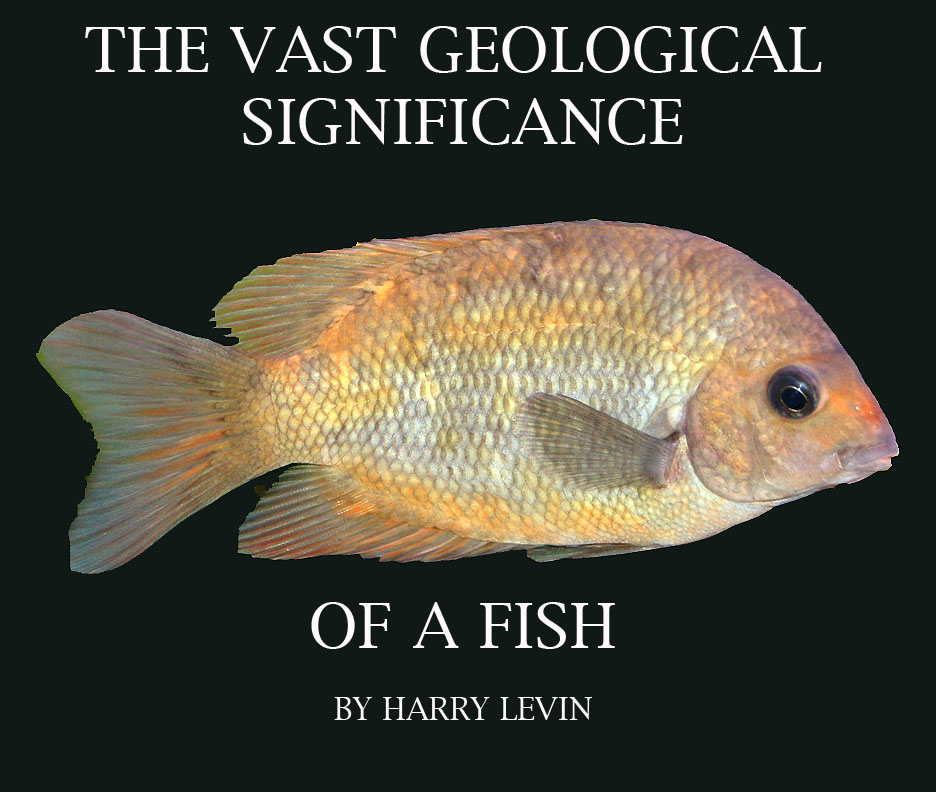
Paretroplus kieneri from NW Madagascar - a cichlid genus whose closest relatives are found in India,
e.g. Etroplus maculatus. Image from photograph courtesy of Christophe Mailliet
The Vast Geological Significance of a Fish
By Harry Levin
Copyrighted
Essay Number Eight
This work represents another in a series of ten essays on natural history by Dr. Levin, who brings the analytical skills of an engineer to bear upon several disciplines in the natural sciences. Dr. Levin's essays are presented here for the first time. He has written on the Origin of Flowering Plants, the Proteaceae (a pictorial essay), The Ancient Land Link between South America and New Zealand, and The Dominance of the Dinosaur. These and other essays are listed on the contents page. He has also contributed unsurpassed photographs of flowers.
"To biology and geology," writes Dr. Levin, "I bring a third viewpoint – that of the engineer. The engineer, in a best aspect of his profession, strives to resolve situations involving multivariables and their interactions. In ten essays, this engineer presents a startling reexamination of earth history. These essays provide accounts of hitherto unsuspected history of the late Paleozoic and the Mesozoic. They do so by interacting biological and geological events that occurred at the same time. The interweaving here of geophysics and biophysics – both embracing climatology – brings out clarifying and sometimes incontrovertible evidence – content otherwise obscure to, or hidden from, either one or the other of these disciplines when it acts alone."
 Dr. Harry Levin |
The fish family
Cichlidae clarify the Mesozoic geographical relationships of India to
Madagascar and of Madagascar to Africa.
The Cichlidae evolved
from saltwater fish, to brackish-water (estuarial) fish to freshwater
fish, roughly after the start of the Permian (280 Ma) to the end of the
Triassic (208Ma), by adapting to land movement and climate change.
Having traced out pathways by species radiation, certain of these fish
today delineate ancient geography. |
Introduction
A family of fish, the Cichlidae, tell a remarkable tale about the history of the earth: Madagascar, until about 245 million years ago, was part of India. Specifically, the upper northeast coast of Madagascar was joined to the coast of later-day Kerala, along almost the full extent of both until about 245 Ma.
Moreover, at approximately its mid-length, Madagascar at that time was connected to Africa by land bridge.
See Figures 1 and 2.
This thesis holds that the cichlids were among the earliest freshwater fish. Cichlids evolved along the southeast coast of India first as brackish water fish between 280 and 250 Ma. They spread out along the eastern coastline of Madagascar, which was in process of separation from India. In northwest Madagascar, cichlid genera evolved into freshwater fish prior to 240 Ma and crossed the land bridge into Africa. Diversifying rapidly, freshwater cichlids radiated across Africa; and they entered South America before 150 Ma.
Conception of Permo-Carboniferous Land Relationships
as Evidenced by Primitive Present-Day Endemic Cichlids:
Paretroplus Polyactis and Etroplus Suratensis.
Colors Mark Present Day Habitats.
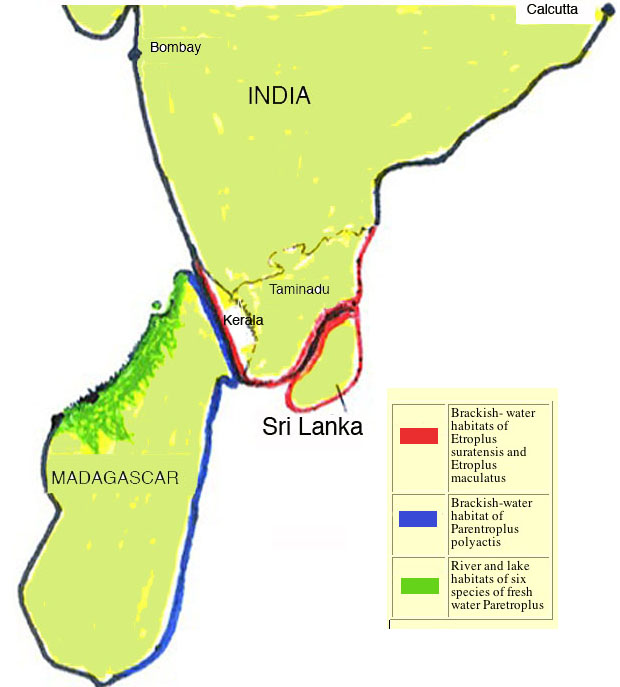
Figure Two
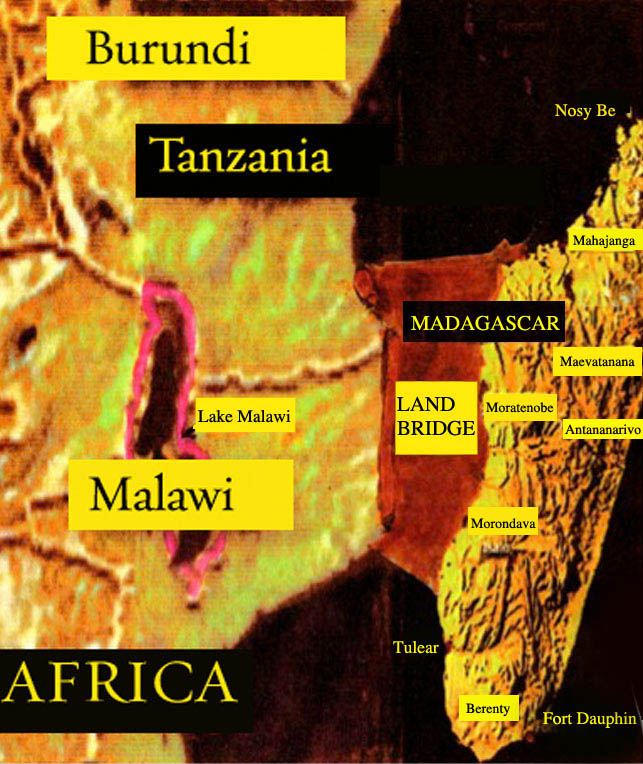 |
Conceptual sketch of Madagasar and Africa geography 250 to 240 million years ago, showing an overland passage, a land bridge, existing between Madagascar and Africa, placed there by reason of mainland proximity, prevailing ice-age low sea level, and the movement of ice-field till and other sediment off both lands. Sketch is not to scale. |
The above cichlid evolutionary history brings to light two significant geological relationships in regard to Africa, Madagascar, and India during the late Paleozoic and Mesozoic eras, namely:
Madagascar was the southernmost part of India during the late Paleozoic until about 245 Ma, as in Figure 1.
Madagascar was connected to Africa by land bridge during the late Paleozoic and the Mesozoic (actually from about 280 Ma to 50 Ma), as in Figure 2.
3
“The exceptional diversity of the [fresh-water fish] family Cichlidae, [order Perciformes] has elevated it to an icon in textbooks of evolutionary biology,” wrote M. Stiassny and A. Meyer in 1999 (1), and continued with: “[Cichlids] come in a vast assortment of colors, forms, and habits. They are indigenous to warm rivers and lakes in Africa, Madagascar, southern India, Sri Lanka, and South and Central America . . . with one species, the Texas cichlid, making it into North America . . . Most of these regions were part of the ancient southern continent of Gondwana, which fragmented 180 million years ago; the observation suggests an ancient lineage for the family. (Curiously, the fossil record is silent on this issue until the past 30 million years.)”
Stiassny had previously observed that among the numerous species of these perch-like fish, 15 species are found in Madagascar and 3 in southernmost India. The authors noted: “These [eighteen] fishes appear to be survivors from the very earliest lineages. (Many such ancient species survive in Madagascar, which their competitors, evolving in Africa, could not reach; India, too, was isolated for millions of years.) . . . by far the most abundant diversity of cichlids occurs in Africa, in particular the great East African lakes of Victoria, Malawi, and Tanganyika.”
The eighteen species “survivors from the very earliest lineages” hint of an affinity between Madagascar and southern India in the distant past. Can these present-day cichlids of Madagascar and India be closely enough related to justify a conclusion that their ancestors passed over from one body of land to the other? Madagascar and India are now about 4500 km apart.
Geological Setting
In 1971, when the concept of continental drift had just emerged from heresy to orthodoxy, D.H. Tarling and M.P. Tarling (2) had charted Madagascar of 300 to 250 million years ago with respect to Africa; to wit, at approximately its mid-length, Madagascar was opposite to (and at the same latitude as) Lake Malawi in Africa. The relationships of Madagascar to both India and Africa in the late Paleozoic and, in particular, in the time frame from 250 to 240 million years ago, have been, however, a contentious matter among geophysicists. Mostly, convention among geophysicists today appears to place the Madagascar of 250 million years ago contiguous to, or closely nestled with, Somalia, Kenya, and Tanzania; and, in respect to India, off and opposite to its western coastline from just south of Gujarat to the southern tip of Kerala. The cichlids provide substantial reason to reexamine the correctness or falsity of hypotheses concerning the relative positions of Africa, Madagascar, and India over time.
Biological Isolation of Australia at Start of Permian 280 Ma
The observation that there are no indigenous cichlids in Australia becomes significant in reading the clock of earth history. Probably 280 million years ago, at the start of the Permian, Australia became biologically isolated by water, except for reptiles capable of swimming long distances over water. The evidence is the early warming and attendant rise in sea level on coastal Australia in the midst of the Permo-Carboniferous glaciation (300-250 Ma), as follows: In evidence, a momentous sea level rise occurred in the geological history of Australia about 280 million years ago, at the beginning of the Permian.
P. V. Rich et al (1985) (3) wrote: “Sometime in the early Permian, the ice began to shrink [in Australia]. It probably disappeared earlier from Western Australia than it did from the eastern part of the continent . . .
The seas formed deep bays on the Western Australia coastal margin.”
In evidence, the Tarlings’ 300-250 Ma geographic chart (2), presented herein as Figure 3, indicates a complete isolation by water of Australia from India and, in fact, from the rest of Gondwanaland. The inference is here taken that at a time during the Permo-Carboniferous Ice Age, 300-250 Ma, Australia had become biologically isolated.
In evidence, M.T. Gibbs et al (2002) (4) wrote: “The Permian Period . . . contains the most recent transformation from a major glaciation to a generally ice-free state . . . Apparently, the deglaciation was relatively rapid, being mainly confined to the Early Permian Sakmarian [285-280 Ma] Stage . . . [A Glossopteris forest cover replaced ice sheets] and the early and ubiquitous Gandawanan sequence, from tillites to coal swamp deposits, indicates a major climate warming . . . ”
This cichlid account and other ensuing evidence substantially supports the Tarlings’ findings (2) in respect to the relative positions of Africa and Madagascar until about 250 million years ago. Until then, Madagascar was still part of India, integral with the Kerala coast (Figure 1); and until about 220 million years ago cichlids could cross between Africa and Madagascar via land bridge opposite Lake Malawi (Figure 2).
Madagascar today has moved in respect to Africa. Madagascar is positioned about 500 km. farther south in respect to Africa. This displacement occurred relatively recently (in terms of millions of years). It was mainly due to Africa moving north after its severance from Antarctica about 150 Ma.
A Post-Ice-Age Land Bridge Between Africa and Madagascar
Beginning 300 million years ago, and lasting 50 million years, the Permo-Carboniferous Ice Age (also known as the Gondwanaland Ice Age) dwarfed recent glaciations like those of the Pleistocene. The movements of the ice fields are described by the Tarlings (2) in Figure 3. In initial onslaughts, Southern Africa and Southeastern South America were engulfed. A huge ice salient reached into Central Africa; and in South America, ice cover extended into the lower part of Brazil. Parts of India and Madagascar were iced over.
Figure Three
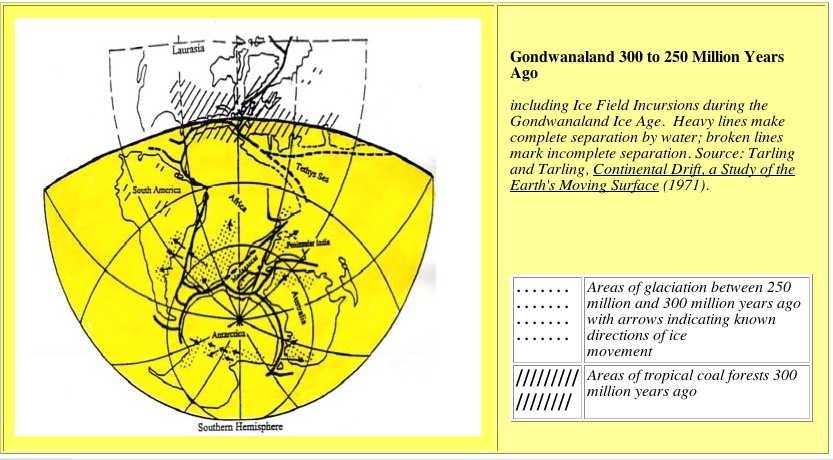
By 250 Ma, Africa and Madagascar, though separated, were in relatively close proximity (Figures 2). In hypothesis, a land bridge consisting partly of glacial debris connected the two lands, and at times it was crossable. The land bridge is of such importance that it is here delimited as follows.
On the African side, it was built by sediment (initially glacial till) washed from a vast Zambezi Basin watershed. Today, the Zambezi Basin consists of Malawi, Tanzania, Mozambique, and the riparian parts of five other countries. It lies between latitudes 8 S and 20 S; and it is more than 1.3 million square kilometers in area. The basin has its delta at the Indian Ocean with rivers, lakes and poorly drained wetlands such as marshes, lagoons, and flood plains. It is a plentiful source of cichlids.
On the Madagascar side, the land bridge received sediment in coastal continuity from the southern part of the Mahajanga Basin to the northern part of the Morondava Basin – attrition (initially glacial till) washed down from the west versant of the central mountains. In width, the land bridge includes both the latitude of the Maevarano Formation (site of titanosaurid and abelisaurid fossils (5) and the latitude of the 230-million-year-old fossil site of prosauropods.
In summary, 250 to 240 million years ago an overland passage (land bridge) existed between Africa and Madagascar, placed there by condition of mainland proximity; the prevailing ice-age low sea level; and the movement of ice-field till and sediment off both lands. This bridge passage came into existence long before the end of the Permian (240 million years ago). It was partly above water from 240 to 220 Ma; and it submerged from 220 to 85 Ma; and again it emerged in part from 85 Ma until well into the Cenozoic. Africa and Madagascar drifted apart about 50 Ma.
All three species of cichlids cited by Stiassny and Meyer (1) as indigenous to southern India are of the genus Etroplus and are considered to be relatively primitive. Significantly, one among the genera comprising Stiassny’s fifteen Madagascar species is Paretroplus, which name can be interpreted as “on an equal footing with Etroplus.” In support of a possibly close relationship, a newsletter (6) dated 1997 by Vinny Kutty states: “Their [the Etropli of India] appearance and behavior are remarkably similar to the Paretroplus sp. from Madagascar.” This observation seems significant, especially in view of the fact that cichlids are known to manifest a high degree of variability of body shape and reproductive behavior.
Today Paretroplus of Madagascar and Etroplus of India -- and in particular, P. polyactis, E. suratensis and E. maculates – are exceptional among cichlids as primitive brackish water species. Importantly, E. suratensis and E. maculatus, together with their extremely close relative, P. polyactis, bring to light geographical relationships that geophysics, acting alone, has been unable to elicit.
E. suratensis and E. maculatus are known also as the green chromite and the orange chromite, respectively. Today, E. suratensis and E. maculatus inhabit the entire coastline bordering the southernmost states of India: Kerala on the west and the much larger Tamilnadu on the east (and slightly on the west). Both species are found in the same brackish waters. There is also a third species, E. canarensis, last reported in a native habitat at the north tip of Kerala and perhaps now extinct except in aquaria. Follow Figure 1, which very much facilitates the telling of the story.
As well, E. suratensis and E. maculatus inhabit the entire coastline of Sri Lanka.
Following Figure 1, P. polyactis today is the sole inhabitant among Paretropli of the entire eastern coastline of Madagascar, from Antsirana (Diego Suarez) to Tolanaro (Fort Dauphin).
There exist six species of the primitive Paretropli that are all freshwater fish; and they are endemic to the northwest versant of Madagascar, to the rivers, lakes, and watersheds from above Nosy Be (offshore) south to below Maevatanana (now at roughly 17 S latitude). (These freshwater species are all endangered by deforestation and by the commercial introduction of exotic fish.)
As cited above, V. Kutty observed, concerning the Etropli, that “their appearance and behavior are remarkably similar to the Paretroplus sp. of Madagascar.” The kinship is especially startling between E. suratensis (of India and Sri Lanka) and P. polyactis (of Madagascar). “The similarity between Paretroplus polyactis and Etroplus suratensis cannot be disputed superficially . . . ” according to Sonia Guinane (7). As an aquarist, she does point to apparent physiological differences, such as feeding habits.
While P. polyactis is “omnivorous,” as noted by Guinane, and E. suratensis is card-indexed as an “omnivore vegetarian,” perhaps the difference is germane, but feeding habits can be expected to diverge, due to passage of tens of millions of years in vastly separated locations.
Passage between India and Madagascar
E. suratensis and E. maculatus are indigenous to the entire coastlines of both Tamilnadu and Sri Lanka. This commonality of habitation is strong evidence that Sri Lanka was attached to Tamilnadu and, except for Madagascar, was the farthest south reach of India more than 300 million years ago.
The invasion of oceanic water with the rise in sea level about 250 million years ago (at the close of the Permo-Carbonaceous Ice Age) caused inundation; and it drew apart similar Etropli of Sri Lanka and Tamilnadu, in adjustment to new-formed coastline. Likely, the splitting-off of Sri Lanka began at that time of rising sea level; and the (triangular) gap slowly widened to form the Gulf of Mannar between.
E. suratensis and E. maculatus, together with their extremely close relative, P. polyactis, are able to affix the positional relationship of India and Madagascar that existed when they first began separation by ocean about 250 million years ago.
In other words, Madagascar was southernmost India 300 million years ago. Figure 1 shows the Madagascar, Indian, and Sri Lanka relationship as it existed in the late Permian – along with the E. suratensis, E. maculatus, and P. polyactis relationship at the present time. The onset of separation of India from Madagascar at the end of the Gondwanaland Ice Age 250 million years ago may mark the start of the evolution of freshwater cichlids. In hypothesis, at that very time, freshwater Paretropli were just beginning to evolve abetted by the freshening of delta waterways with the disappearance of montane ice cover. (Other freshwater fish concomitantly may have been evolving elsewhere.)
The northeast edge of Madagascar that was once attached to Kerala extends about 450 km. (Today the Kerala coast tip to tip is about 450 km. The southwest coastline of India actually extends beyond Kerala to Cape Cormorin, making a total length of about 480 km from the upper tip of Kerala.) The ancient relationship (in Figure 1) is based on hypothesis of ecological continuation by newly generated coastline formation when oceanic invasion (rising sea level) leads to gradual separation of landmasses, as, for example, of Northeast Madagascar from Kerala.
The last stages of the Permo-Carboniferous Ice Age, from 280 Ma to 250 Ma, produced copious outflows of fresh water from the land. Ever seeking to radiate under pressure to survive, fish have extended their domains, in sequence, from oceanic salt water first to brackish (low-salt) waters and then to freshwater rivers and lakes. Hence, the first fish to invade land waters from the ocean became brackish-water fish, tolerant of the low-salt content of estuarial (tideland) outflow.
Linkages such as land bridges between land masses clearly allows for crisscrossing rivers and streams open to fish. While no precise date can be given for the breaking off of the fresh or brackish water linkage between India and Madagascar, this account points to its probable occurrence at a time of heightened (probably catastrophic) end-of-Permian geological activity, about 240 million years ago. That date would seem noteworthy in estimating the minimum span of existence of the cichlid – assuming that up to the time of disconnect, cichlids had passed freely in watery conduit between India and Madagascar for millions of years.
Thus, Permian passage of cichlids between Madagascar and India seems tenable. In brief, geological circumstances indicate that the cichlid fish family was present in Gondwanaland (i.e., in a united Madagascar-India) before 240 million years ago (or before whatever date might be more firmly affixed to the biological separation of Madagascar and India). In estimation then, at the end of the Permian, about 245 to 240 million years ago, India separated cleanly from a restraining Madagascar (as in fanciful analogy, a lizard may break off the tail by which it is trapped).
A similar hypothesis of radiation, this time over a land bridge formation, can shed light on the migration of freshwater cichlids from Madagascar into Africa and can provide a strong basis for positioning Madagascar in respect to Africa (and hence India in ancient respect to Africa), as follows:
The location of a land bridge between Madagascar and Africa is told by Paretroplus. On the west versant of Madagascar of 250 Ma, the waters freshened with the melted ice, and freshwater biota became more plentiful as fish food at the lower reaches of the land. During this time six species of Paretroplus evolved in Madagascar as first freshwater cichlids. They inhabited the northwestern regions of Madagascar down to the sea. See Figure 1. They made their way down the western slopes of the Sophia Basin and the Mahajanga watershed region across a land bridge to Africa.
Maevatanana, in Madagascar, as shown in Figure 2, was positioned, then, 250 million years ago, opposite Lake Malawi, about midway between top and bottom. Maevatanana lies slightly south of the headwaters of the Mahajanga (Majunga) Basin of freshwater rivers and lakes inhabited by cichlids.
The cichlids, in radiation into Africa from Madagascar, evidently targeted Lake Malawi, then in latitude opposite Maevatanana. Today Lake Malawi, third largest lake in Africa, is said to hold 500 to 1000 species of cichlids, many unknown, comprising 30% of all cichlid species. That Lake Malawi was the hub for African radiation may be inferred in Stiassny and Meyer (1): “All the cichlids of Lake Malawi are more closely related to one another than to any cichlids in Lake Tanganyika.” Cichlids radiated and diversified into Lake Tanganyika, Lake Victoria, and other Great Rift Valley waters.
There, in Africa, ecological niches burgeoned to invite diversification. Adaptations followed and produced numerous new genera of cichlids (which seem remarkably capable of rapid genetic change).
For reasons of geological activity and rising sea level, it is conjectured here that the land bridge biologically linking Madagascar and Africa became submerged about 240 million years ago. (Maevatanana is today about 17 S. Hence Maevatanana has been displaced south about 500 km. from its former position in reference to present-day Lake Malawi.)
Footnote: Phytoconfirmatory Evidence
In addition to the above ancient geography lesson offered by a fish, confirmatory evidence of the late-Paleozoic India, Sri Lanka, Madagascar conformation (Figure 1) is offered by two pitcher plants: namely, Nepenthes distilloria of Sri Lanka and Nepenthes masoalensis of Madagascar, both of order Caryophyllales, family Nepenthaceae. See Figure 4. N. distillatoria is the only pitcher plant endemic to Sri Lanka. N. masoalensis is one of only two pitcher plants endemic to Madagascar.
N. distillatoria until recently was abundant in the lowland vicinity of Colombo on the lower west coast of Sri Lanka. N. masoalesis, in name, tells that its habitat is identified with the northeast peninsula of Madagascar, the Parc National Masoal. That peninsula was in the past attached to India, in close proximity to Sri Lanka, as sketched in Figure 1.
Hence, here is evidence of an erstwhile overland floral link between Madagascar and nearby Sri Lanka. The flower forms and the stem connections of the two species in Figure 4 profess similarity. Both species favor rainforests or wetlands but grow also at low elevations. They are among the more primitive of the Nepenthes. Rudolf Schmid-Hollinger (8) has suggested that these two species are members of a closely related group, the result of a single dispersion.
| Nepenthes distillatoria, only species
endemic to Sri Lanka; and Nepenthes masoalensis, one of two Madagascar
species, endemic to eastern Madagascar. These more primitive among
Nepenthes are closely related, indicating an ancient (Permian) overland
radiation route between Madagascar and Sri Lanka. |
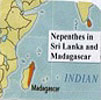 |
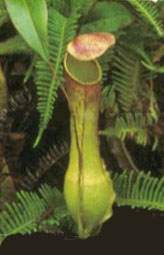 Sri Lanka, Nepenthes distilloria, from photo by Joachim Nerz 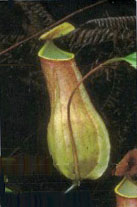 Sri Lanka, Nepenthes distilloria, from photo by Joachim Nerz |
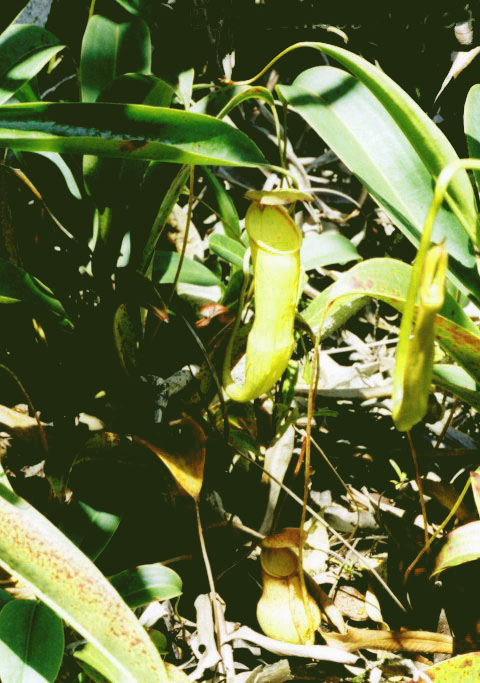 Nepenthes masoalensis Madagascar Photo by Eric Schlosser |
12
The piscine family Cichlidae has told a remarkable tale of the history of the earth, namely: Madagascar, until about 245 million years ago, was the tail-end part of India. At approximately its mid-length, Madagascar was located opposite to Lake Malawi in Africa and at the same latitude. It was connected to Africa by a land bridge until about 50 million years ago. The cichlids affirm a message of earth history, namely: the interweaving of concurrent biology and geology of the past brings forth clarifying evidence – evidence otherwise obscure to, or hidden from, one or the other of the disciplines when it acts alone.
There are no indigenous species of cichlids in Australia and the Far East. The biological separation of Australia and India (by water) is estimated herein to have occurred during the Permo-Carboniferous Ice Age, 280 million years ago. Hence, it is indicated that the cichlids have been present in Gondwanaland for fewer than 280 million years. These findings can be important in surmising a minimum age for the entire ray-finned interclass Teleostei to which the cichlids belong.
L’envoi In Praise of Paretroplus, Past and Repast
Upon that great gromboolian plain, Gondwanaland,
Did this first fizzgiggious fish appear.
(Some canny readers of this fare will be aware
Of the splendorous words of Edward Lear.)
References
1. Stiassny, M.L.J. and Meyer, A., Cichlids of the Rift Lakes, Scientific American 282, 64-69, (1999).
2. Tarling, D.H. and Tarling, M.P., Continental Drift, a
Study
of the Earth’s Moving Surface, G. Bell and Sons;
London, 1971.
3. Rich, P.V., van Tets, G.F., and Knight, F., Kadimakara, p. 77, Pioneer Design Studio, Victoria, Australia, 1985.
4. Gibbs, M.T., Rees, P.M., Kutzbach, J.E., Ziegler, A.M., Behling, P.J., and Rowley, D.B., Simulations ofPermian climate and comparisons with climate-sensitive sediments, The Journal of Geology, 110, 33-55, (2002).
5. Rogers, R.R.; Krause, D.W. and Rogers, K.C. ,
Cannibalism in the Madagascar dinosaur Mejungatholus atopsus,
Nature 422(3), 513-518 (2003)
6. Kutty, V., Newsletter of the Tampa Bay Aquarium Society, spring, 1997.
7. Guinine, S., The Madagascan cichlid genus
Paretroplus
(Bleeker, 1865), The Cichlid Room Companion, 9,
7 pages, (2000).
8. Schmid-Hollinger, R., Nepenthes-studien v. die
kannenformen
der westlichen nepenthes-arten, Bot. Jahrb. Syst.
100,
379-405, (1979).